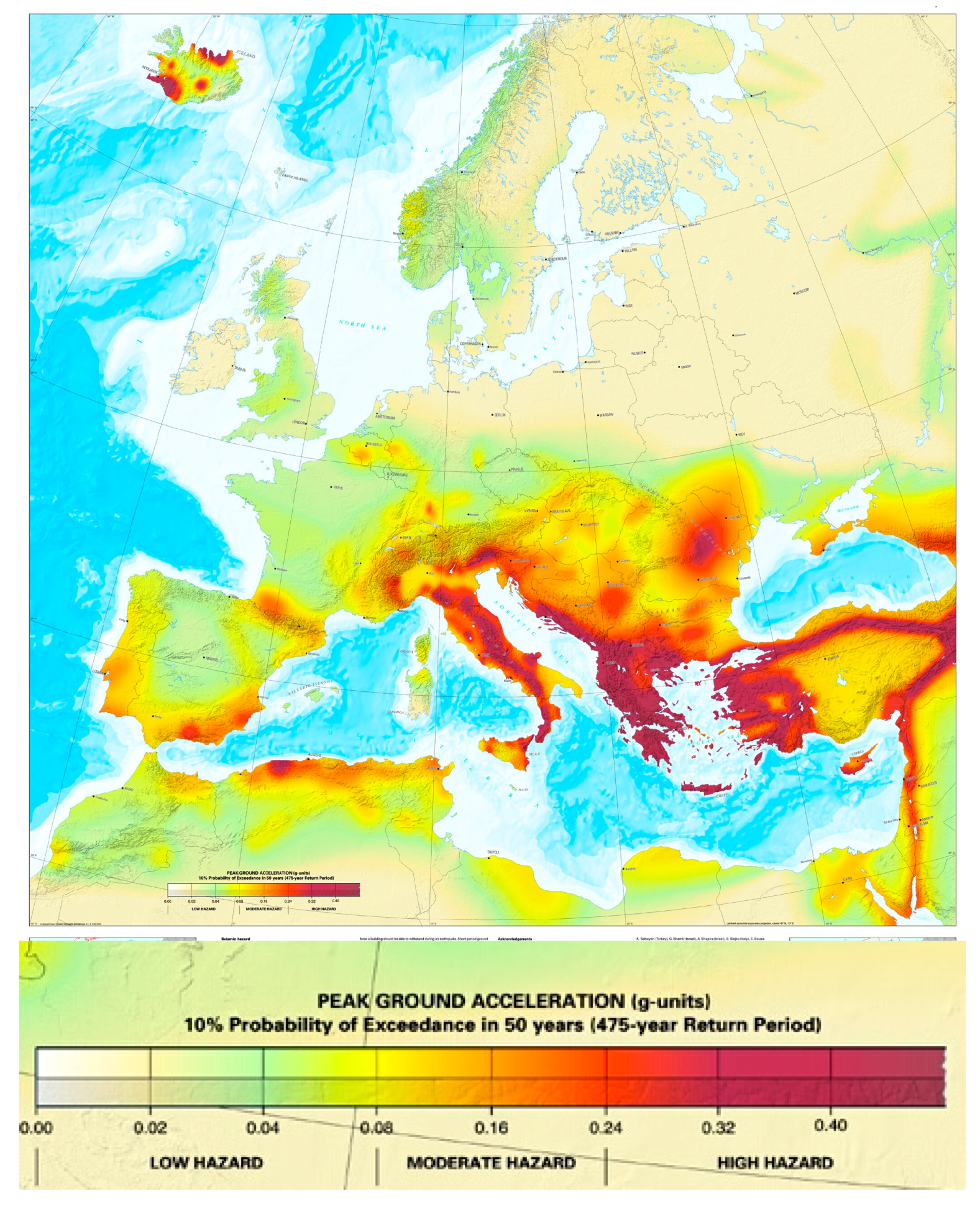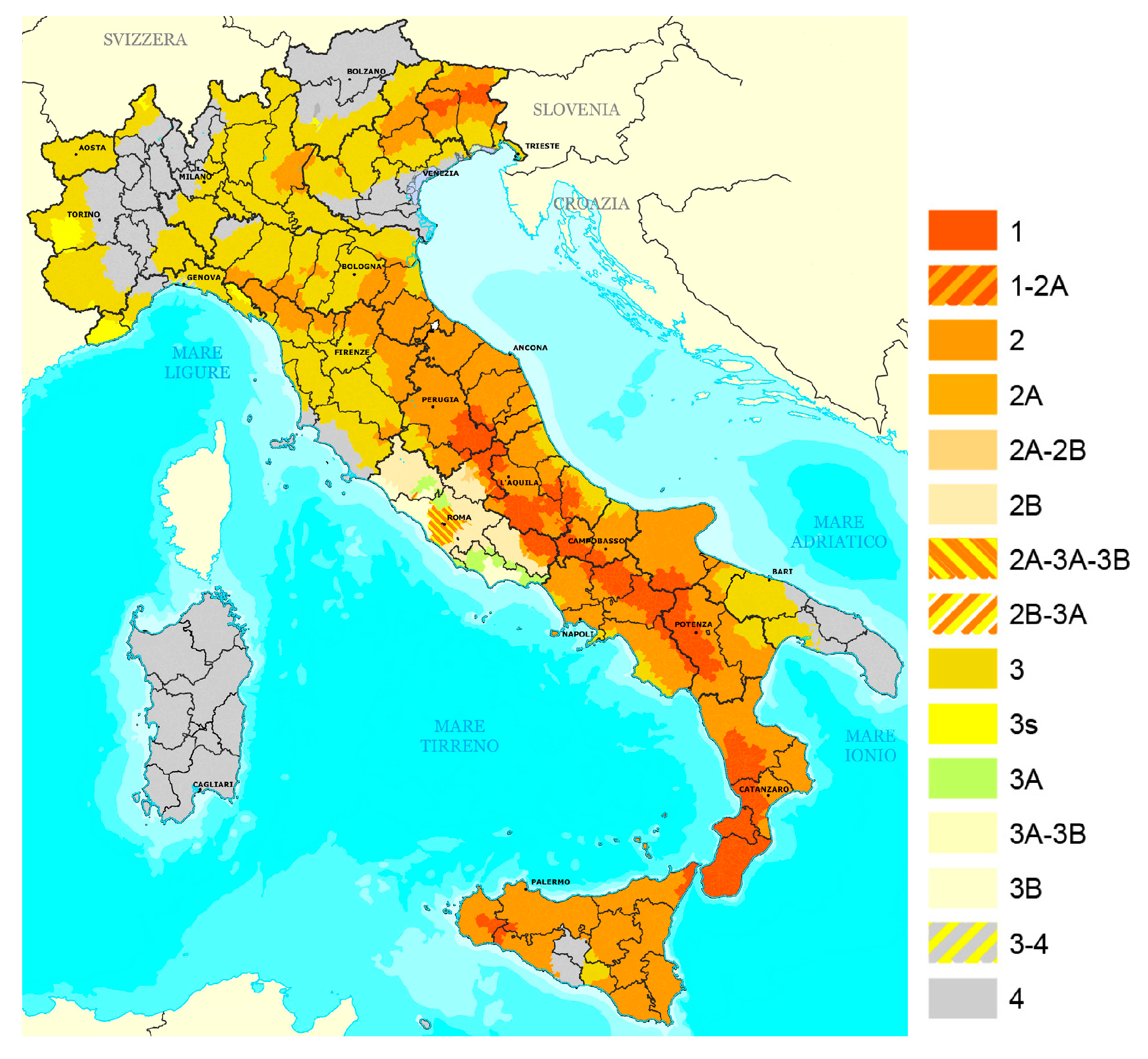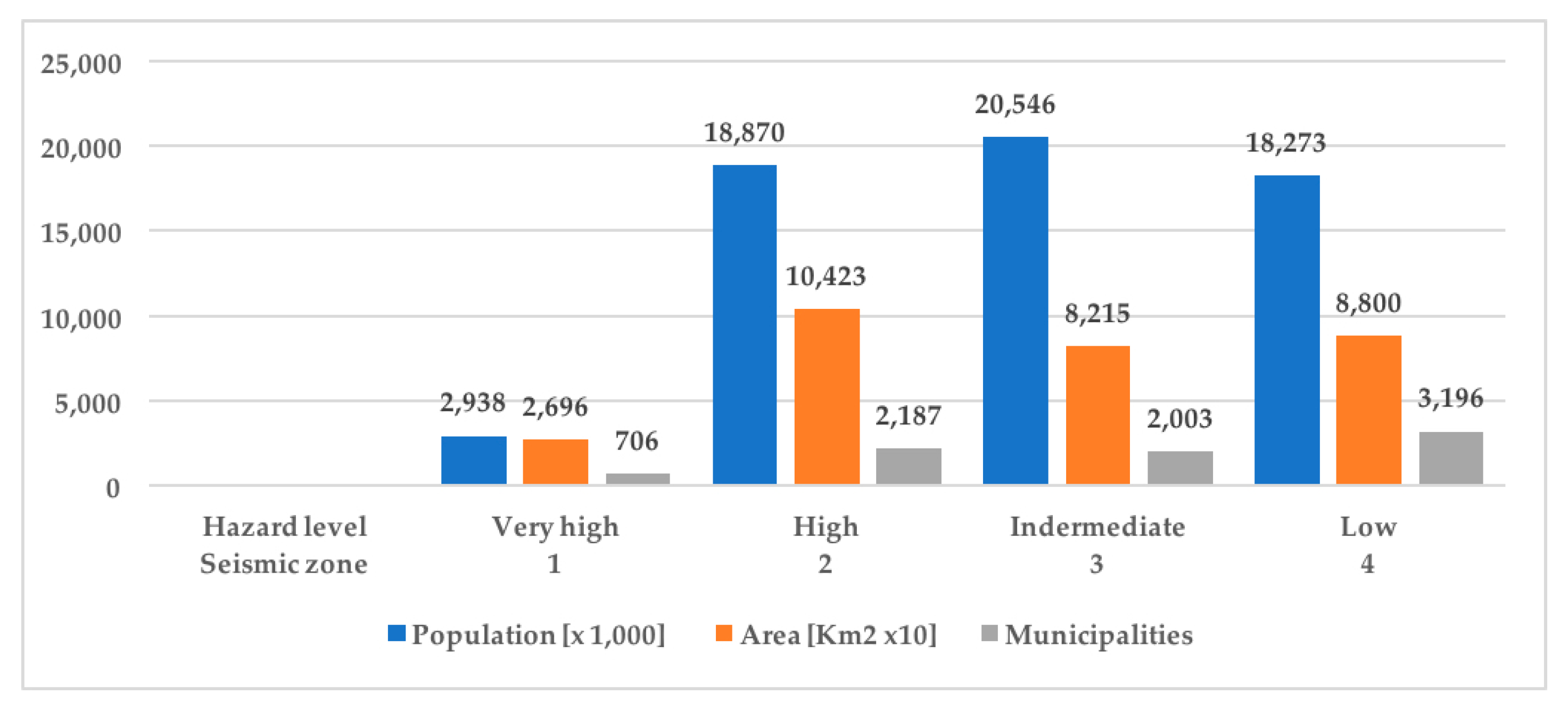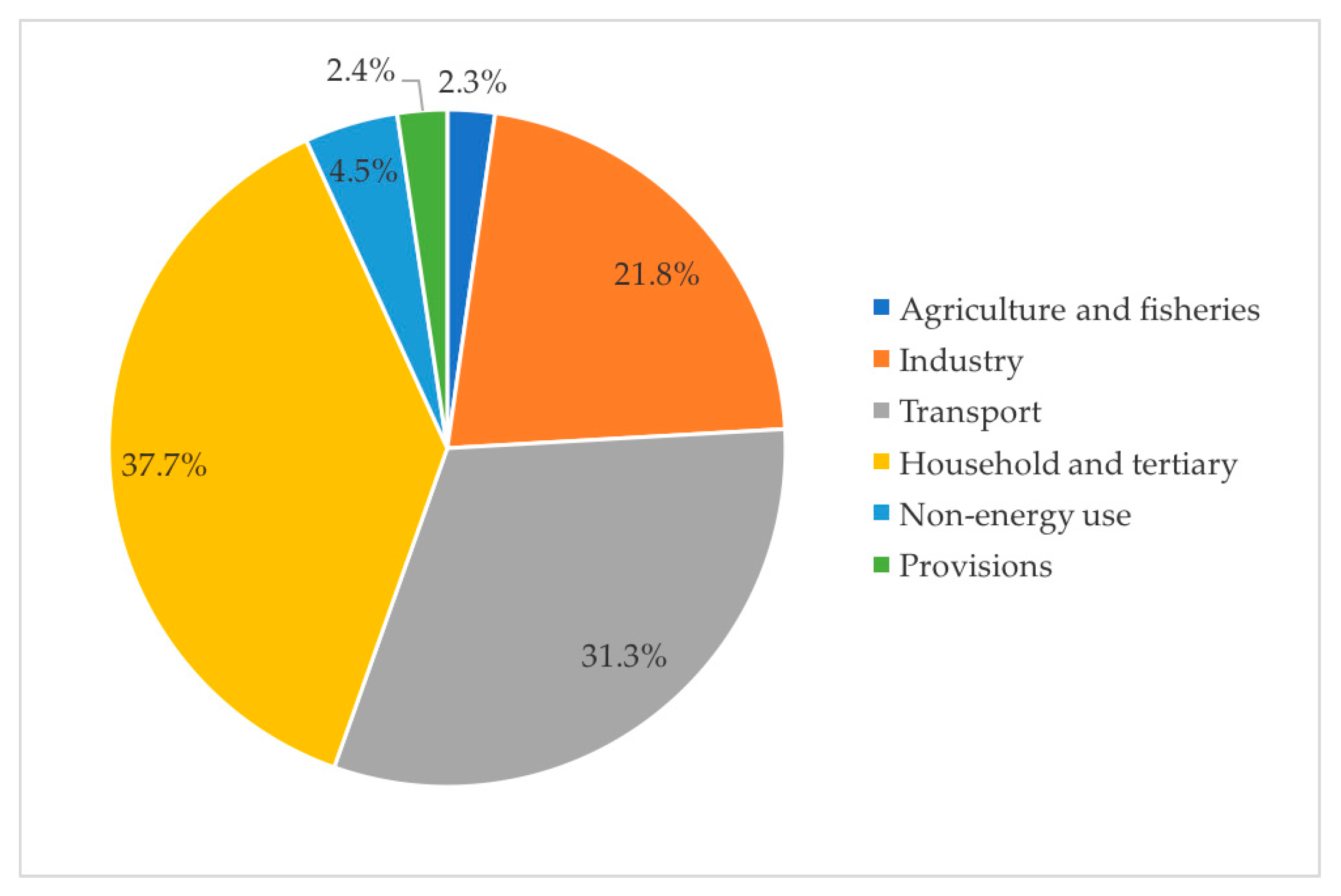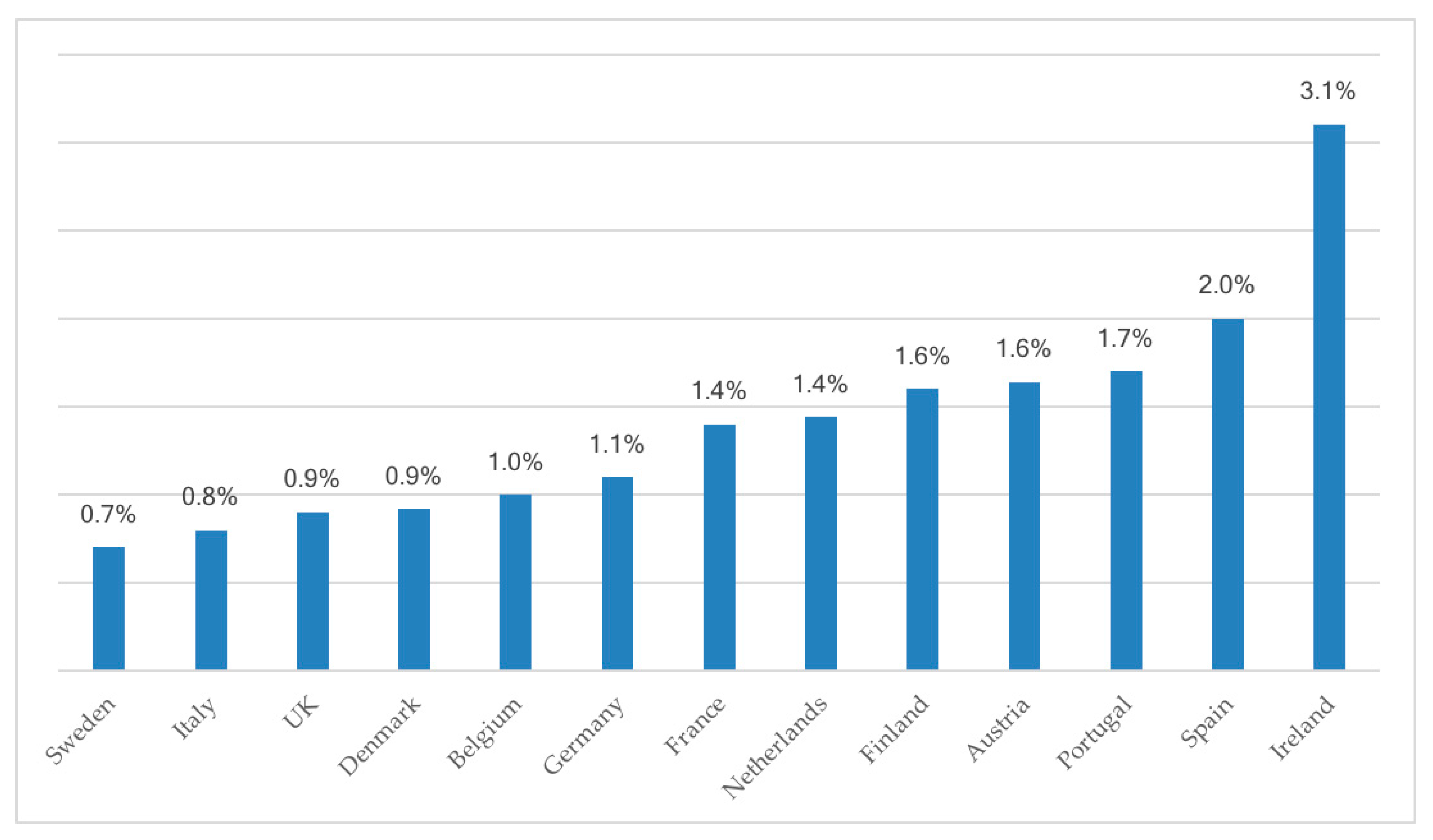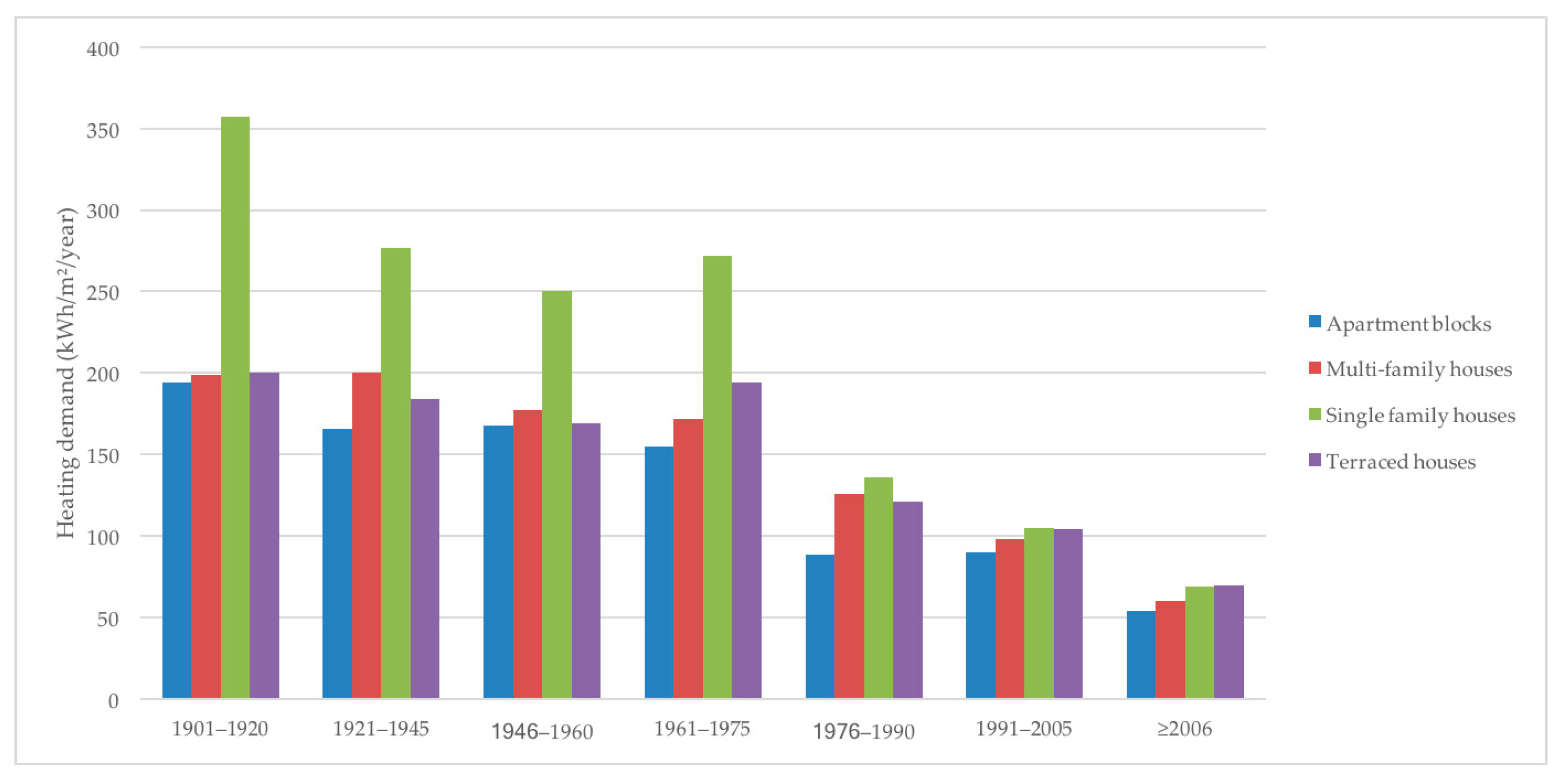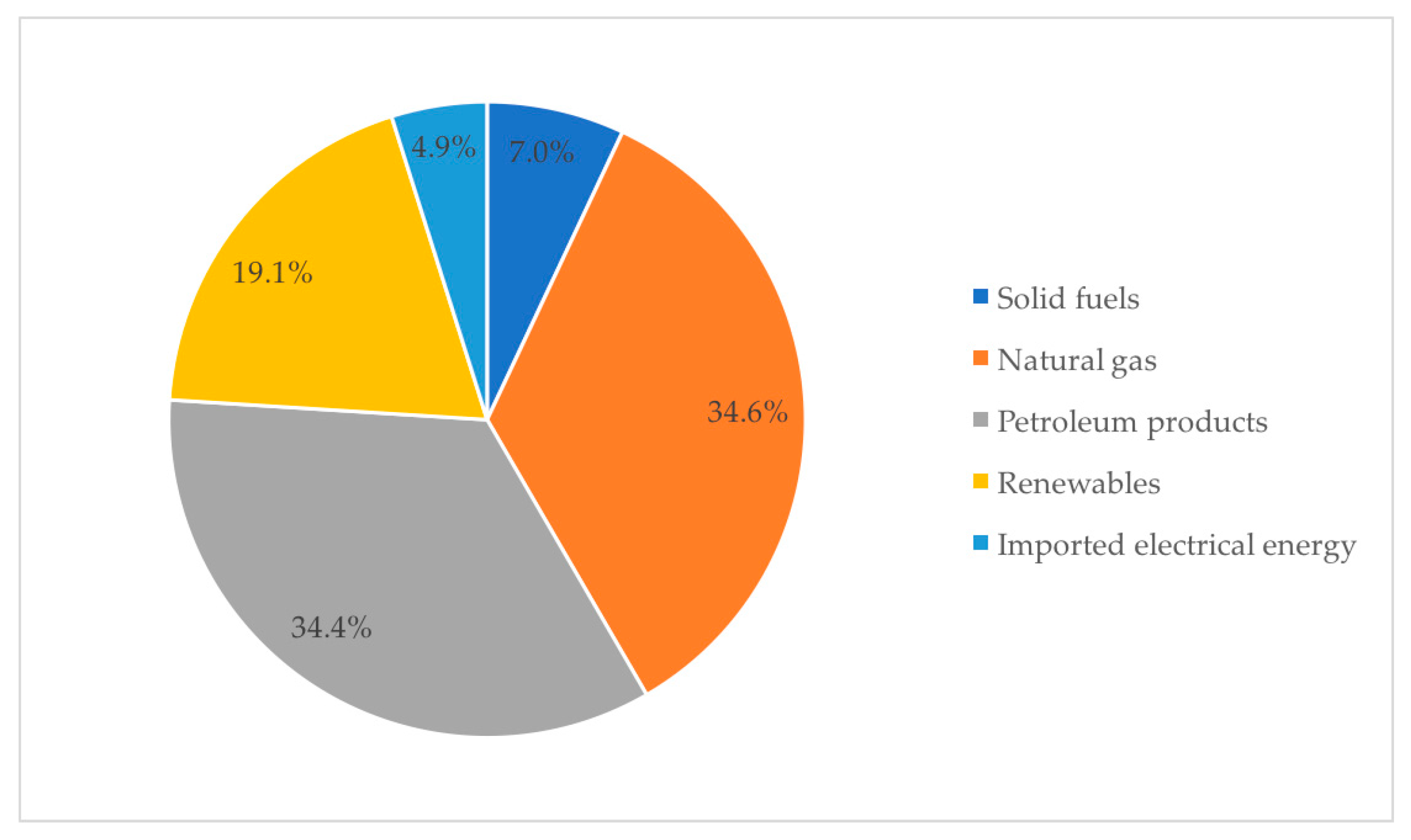1. Introduction
Sustainability was not an explicit value until the last quarter of the 20th century; therefore, sustainability performances were not requested in the recent past.
The approach has changed in connection with the intensification of climate change, environmental degradation, overconsumption of natural resources, population growth and pursuit of incessant economic rise. Today, sustainability is instead considered a fundamental quality and a prerogative in any socio-economic context.
According to the definition of the 2005 United Nations World Summit, sustainability is based on three main pillars: environment, society and economy [
1]. However, the social dimension, and in particular safety, has often been neglected, especially in relation to the vulnerability of the building stock.
In the last years, the EU has produced big financial efforts to increase the sustainability level of our cities and, in the 2014–2020 budget, over 5% of the European Regional Development Fund has been allocated to sustainable urban development [
2,
3,
4].
These resources have mainly been driven towards energy efficiency and low-carbon measures, to reduce the energy bills and the hazard risks related to climate-change (e.g., hurricanes, floods, storms, landslides, desertification, melting of glaciers and sea level rise) that may cause significant damages and life losses. Special attention has been paid to existing buildings, which are responsible for about 40% of the final energy demand and therefore represent a great opportunity for energy saving and decarbonization [
4,
5,
6]. In particular, renovation activities have been privileged over new constructions to limit urban-sprawl and soil consumption, according to the European aim to achieve no net land take by 2050 [
7].
However, less effort has been made to reduce the seismic vulnerability of the existing real estate, mostly due to the high rate of European countries that are not listed as earthquake-prone (
Figure 1). Consequently, the sustainability level of towns placed in seismic areas remains inadequate, since most buildings and infrastructures are unsafe, i.e., not sufficiently earthquake-resistant.
In such areas, energy renovation actions must be synergistically combined with seismic retrofitting, for two main reasons: (a) to prevent life losses and damages caused by earthquakes; and (b) to avoid several costs otherwise duplicated, for instance those for building-site setup and scaffolds, as well as for cladding, plasters and other finishing [
9]. As illustrated by Belleri and Marini, in the case of energy refurbishment only, the risk of a building located in seismic regions can be equalized to an additional annual embodied equivalent CO
2 that almost equals its annual operational CO
2 [
10].
Nevertheless, several barriers considerably limit the real possibility to extensively undertake combined retrofit actions, especially for multi-owner housing and high-rise buildings. These barriers are of different kinds: (i) technical (e.g., unfeasibility and/or ineffectiveness of conventional retrofit solutions, and need of regulatory simplification); (ii) financial (e.g., high renovation costs, “split-incentive”/“landlord–tenant dilemma”, and insufficient incentives and subsidies); (iii) organizational (e.g., temporary alternate accommodation for occupants, consensus to the retrofit expenditure by condominium ownerships, and excessive time to obtain building permits); and (iv) cultural/social (insufficient information and skills, and lack of adequate policy measures to promote renovation actions).
According to this general premise, this study intends to fill the gap existing in the scientific literature regarding combined seismic and energy renovation strategies and, in particular, aims to: (a) outline the scenario of seismic vulnerability and energy performance of the Italian residential building stock, with particular reference to that built during 1950–1990; (b) review and discuss the barriers which limit the concrete possibility to extensively undertake combined seismic and energy retrofitting interventions; and (c) suggest and discuss possible countermeasures to overcome such barriers and promote combined renovation actions.
The proposed countermeasures, which will be discussed with specific reference to the Italian reality, may be effectively applied also in other countries with similar hazard scenarios and socio-economic backgrounds, contributing to effectively enhance the sustainability level of their towns.
2. Seismic Vulnerability of the Italian Building Stock and Current Renovation Strategies
2.1. Seismic Vulnerability
Along with Greece, Turkey, Bulgaria, Romania, Iceland and most Balkan states, Italy is listed among the most earthquake-prone European nations (
Figure 1). In these countries, the seismicity is not as high as in the Pacific coast of the Americas or in some Asian regions such as Japan, Indonesia, Philippines, Mongolia, Pakistan, Nepal, or China. Nevertheless, telluric shakes often produce in Europe significant damages for the high vulnerability of the building stock and the considerable value of that large portion classified as historic architectural heritage.
The seismicity of the Italian peninsula is due to its geographic position at the convergence of the Eurasian and African tectonic plates. The relative movement between these plates causes energy accumulation and deformations that are occasionally released in the form of earthquakes of different magnitude. The highest seismicity is concentrated in the central and southern part of the country, along the Apennine chain, in Calabria and Sicily, as well as in some northern regions, such as Friuli-Venezia Giulia.
Since 1974, Italy has been progressively classified into seismic zones, based on past earthquakes intensity and frequency. The last seismic classification map, updated in 2015, has catalogued 44% of the territory and 36% of the municipalities as highly hazardous, i.e., with a peak ground acceleration (PGA) value > 0.15 g (zones 1, 2, 2A, 2B of
Figure 2) and a 10% chance of being exceeded in 50 years [
11]. More in detail, nearly 3 million people live inside areas exposed to a very high-hazard level (zone 1; 0.25 g < PGA ≤ 0.35 g), while 18.8 million in areas exposed to a high-hazard level (zone 2, 2A, 2B; 0.15 g < PGA ≤ 0.25 g), i.e., globally 21.8 million people live in highly earthquake-prone municipalities, that is around 36% of the whole Italian population (
Figure 3).
According to the 2011 census of the Italian national statistical institute (ISTAT), around 2/3 of the existing residential stock was built before 1974 (
Figure 4), i.e., before the enforcement of Law 64/1974 [
13], which represents the first specific and extensive code for earthquake-resistant buildings in Italy. This code applied only to new edifices included in the seismic classification map that has been progressively updated by releasing revised versions. Therefore, after 1974, a great number of Italian municipalities, now included in the map, were not yet classified as seismically vulnerable. Consequently, even after 1974, a significant number of edifices have been designed neglecting the above-mentioned code.
The same census also reported that nearly 1.8 million residential buildings erected before 1974 (i.e., 15% of the overall stock) lie in a poor or mediocre state of conservation, as shown in
Table 1.
Based on this premise, estimating that at least 8% of the post-1974 building stock has been realized out of the seismic codes and considering that, according to
Figure 3, around 70% of the Italian territory is included in areas exposed from a very high to an intermediate-hazard level (zones 1, 2 and 3), today over 50% of the Italian residential buildings (i.e., nearly 6.4 million) are not earthquake-safe and need urgent actions to improve their seismic resilience.
In the last 2500 years, Italy has been hit by over 30,000 earthquakes of medium-high intensity (>IV–V degree of the Mercalli scale), and approximately 560 of VIII intensity or more (nearly one every 4.5 years). The last century has witnessed seven earthquakes with a maximum Moment Magnitude Scale (MMS) greater than or equal to 6.5 (i.e., between X and XI degrees of the Mercalli scale) [
15]. In comparison with other countries, in Italy, the ratio between the damage caused and the energy released by earthquakes is particularly high, due to the high population density and the vulnerability of the building stock.
To perceive the socio-economic consequences of the seismic vulnerability of Italian cities, it must be highlighted that, in the last 50 years, earthquakes have caused around 5000 deaths and over €150 billion damage [
16]. To these figures, one should also add significant psychological consequences, whose effects might be overcome by the whole community only after several decades.
In this sense, the earthquake that struck the region of Abruzzo in April 2009 is emblematic: with a maximum MMS of 6.3, this earthquake caused 308 deaths, over 1500 injuries, nearly 70,000 homeless, and over €10 billion damages [
17]. Today, seven years after, the beautiful and beloved historic center of L’Aquila—capital of the Abruzzo region—is still ruined, since both State and private investors have not yet found sufficient financial resources for its reconstruction. In similar conditions are many other neighboring towns that have been hit by the same earthquake. Recently, from August 2016 to January 2017, a new series of earthquakes with a maximum MMS between 6.0 and 6.5 hit several regions of central Italy, killing 333 people and devastating entire towns, with more than €23 billion damages [
18].
Considering the priorities, it must be pointed out that the financial efforts for seismic retrofit interventions have to be primarily allocated to infrastructures and strategic public buildings, but it is also extremely important to upgrade the residential stock, because it is generally more continuously inhabited and, consequently, produces the highest number of deaths in case of seismic events.
According to this scenario and considering the high frequency of earthquakes in Italy, the seismic retrofit of the existing building stock represents an imperative, since it allows to consistently reduce the extent of damage and the number of victims.
2.2. Current Seismic Retrofit Strategies
Today, there are two main types of seismic retrofit strategies for edifices with reinforced concrete (RC) structure [
19], which in Italy represents the building standard since the 1950s:
strengthening of the existing structure with conventional techniques (jacketing with RC, steel, or fiber-reinforced polymers) and/or addition of extra structural members (pillars, shear walls, beams, foundations) [
20,
21]; and
installation of base isolators and/or energy dissipation devices [
22,
23,
24,
25].
Another possible renovation measure consists in installing an external steel braced frame, which partially wraps the building and reduces its oscillations through energy dissipation devices applied between the nodes of the old and the new structure. Nevertheless, the adoption of this solution is restricted to limited cases, since it is mostly suitable for isolated edifices and generally requires a considerable strengthening of the existing RC frame too.
Historic and listed buildings, which in Europe account for around 30% of the current stock [
4], need dedicated solutions, due to conservation issues and the variety of building fabric [
26]. These edifices in Italy generally have unreinforced masonry bearing walls and, according to their fabric and their cultural value, they request different seismic-retrofit interventions, such as application of anchoring and tying devices, mortar injection, overlay of RC or fiber-reinforced polymer layers, bracing (e.g., steel sections, reinforced masonry, buttresses), insertion of internal or external frames, post-tensioning of unreinforced masonry walls.
A detailed overview and description of the above-mentioned strategies goes beyond the scope of this work.
3. Energy Performance of the Italian Building Stock and Current Renovation Interventions
3.1. Energy Performance
As for many other countries, in Italy, the household and tertiary sector is the most energy-consuming one, accounting for 37.7% of the overall demand (
Figure 5). To reduce the energy need of this sector, in the last decade the Directive on the Energy Performance of Buildings (EPBD) has effectively promoted the increase of the energy performance especially for new buildings.
However, new buildings have little influence on the overall demand, since their incidence on the whole building stock is very low. Nowadays, new edifices increase the existing stock on average by less than 1.5% every year (
Figure 6), while the demolition rate is estimated around 0.2–0.5% per year [
4,
28]. Therefore, nearly 85% of European building stock predicted for 2030 has already been built.
These data suggest the need to improve, above all, the performance of the existing building stock to reduce energy consumptions and greenhouse gas emissions. This applies particularly to Italy, whose edifices are, in general, performing badly. Indeed, here the first regulation concerning the reduction of energy consumption for buildings was issued in 1976 [
29], but it was low-restrictive and often neglected, due to insufficient controls. The first effective and comprehensive legislation was only introduced in 1991 [
30], when 86% of the current residential stock had been already built (
Figure 4). For this reason, today, most Italian edifices are characterized by an annual heating demand ranging from 140 to 220 kWh/m
2 (
Figure 7) [
31,
32,
33], i.e., significantly over the limits set by current laws. Consequently, they need urgent energy retrofitting measures.
According to the National Energy Balance 2016, in Italy, 76% of the energy demand is covered by fossil fuels (
Figure 8), which are mostly imported. This overdependence, along with bad energy performances, lead not only to high energy bills, but also to excessive greenhouse gas and pollutant emissions. Of course, excessive greenhouse gas emissions contribute to global warming and climate changes, which may cause the aforementioned hazardous events. These events, like earthquakes, may produce consistent damage and life losses, thus any effort to reduce their incidence should be promoted.
The decarbonization potentiality of energy retrofitting is undoubtedly relevant, both in Italy and in Europe, as highlighted by studies of the Fraunhofer ISI, which have predicted that energy-upgrade measures in the household and tertiary sector might reduce the overall final energy demand by 25% in the year 2050 [
34,
35,
36].
Apart from environmental issues, the inability of households to adequately heat or cool their homes, due to continuously rising energy costs, may also produce significant social consequences. Houses with poor thermal comfort have a strong impact on health and consequently on healthcare expenditure. Hence, the social return on investment from energy retrofitting can be relevant too.
Energy improvements are today mandatory in Italy when major renovations are made. In particular, when refurbishment activities involve more than 25% of the building envelope, the thermal transmittance (U) of the envelope and the efficiency of the heating and cooling system must be considerably improved [
37]. If the retrofitting involves the entire building envelope, the current regulation also imposes the installation of renewable energy source (RES) systems [
38]. Anyway, it is necessary to respect specific U-values of the envelope components in order to take advantage of the actual fiscal incentives [
39].
3.2. Current Energy Retrofit Interventions
Nowadays, there are two main solutions for enhancing the energy performances of buildings [
40]:
The first solution is generally addressed by increasing the thermal resistance of the building envelope (e.g., application of insulating layers on walls and roofs, and replacement of the existing windows with high-performing ones), by providing sun shading devices, by improving the air-sealing (in particular for cold climates), by exploiting bioclimatic resources (solar radiation, night ventilation, etc.), by improving the efficiency of Heating, Ventilating and Air Conditioning (HVAC) equipment, and by changing operational schedules.
The second strategy, which is often combined with the former one, is mainly accomplished by installing solar panels (photovoltaic, PV, and/or solar thermal, ST), which today represent one of the most cost-effective solutions for energy production on site, especially in southern and central Europe, where sun-based RES systems turn out to be quite efficient [
41,
42,
43].
Both strategies may also be optimized and interconnected by a Building Energy Management System (BEMS), i.e., a computer-based control device that supervises and monitors the mechanical and electrical equipment of the building (e.g., HVAC, RES, lighting and power systems), according to comfort requirements and occupancy regimes. BEMS are currently used mostly for commercial and industrial buildings, but they may be effectively installed also in residential ones.
In addition, in this case, specific solutions should be considered for historic or listed edifices, which present valuable facades not suitable for external insulation application or conventional RES system installation [
44,
45]. These buildings generally need non-invasive retrofit techniques, such as insulating and/or phase-change-material plasters, internal wall insulation [
46,
47,
48,
49,
50,
51], specific solutions for PV or ST integration, etc.
As in
Section 2.2, a detailed analysis of the energy retrofit strategies is here omitted.
4. Barriers to the Seismic and Energy Renovation of Residential Buildings
This section will now consider the technical, financial, bureaucratic, cultural and organizational barriers that might affect combined seismic and energy retrofitting strategies.
The analysis will focus on the Italian residential stock realized from the 1950s to the 1980s, which accounts for around 60% of the current real estate (
Figure 4). Historic or listed edifices are here not included, since for them the retrofit interventions are too closely connected to each specific case and the relative costs are hardly predictable and generalizable.
The principal potential obstacles that may affect this kind of strategies are listed and discussed below.
4.1. Technical Feasibility of Renovation Interventions
The principle of sustainability generally leads to prefer renovation activities over demolition and reconstruction practices [
52,
53,
54,
55], since renovation may keep and reuse many building components (e.g., foundations, structural frame, walls, floor slabs, etc.)—saving resources and reducing waste—and limit urban-sprawl and soil consumption.
However, in particular, seismic renovation can sometimes be technically unfeasible or not recommendable. This applies especially to the edifices in a very poor state of conservation, with weak and carbonated RC and/or affected by significant design or construction errors (e.g., inadequate load-bearing structure, faulty concrete composition and/or compaction). For such buildings, any retrofitting measure may turn out to be ineffective, both from the technical and the economic point of view. In this case, the most sensible solution would be to demolish and reconstruct the edifice.
4.2. Cost of Seismic and Energy Renovation
Costs have usually a key role in undertaking renovation actions. Retrofitting expenditures strongly depend on many variables, such as state of conservation, type of selected intervention, number of stories, total floor area, plan irregularities, presence of adjacent buildings, local seismicity, soil type, local prices for materials and labor, etc.
Recent studies have calculated the costs for the combined energy and seismic retrofit of apartment blocks, which represent one of the most frequent building types constructed in Italian urban areas in the considered period (1950–1990) and, above all, the most inhabited one [
33]. With reference to the renovation strategies described in
Section 2.2 and
Section 3.2, this cost currently ranges from 100 to 230 €/m
3, i.e., between 30,000 and 70,000 € for a 100-m
2 apartment [
56,
57,
58,
59,
60].
The main contribution to these renovation costs is due to the seismic component that ranges from about 50 to 150 €/m3. High expenditures, along with a difficult access to capital and an unwillingness to incur debt, often discourage building owners from supporting seismic renovation practices, especially taking into account that it is uncertain when and where telluric shakes will occur. Therefore, owners might tend to believe that earthquakes will spare their families and properties and consequently to repress eventual prevention activities.
Moreover, families with low incomes have often dwellings with poor seismic and energy performance. This circumstance reduces the opportunity of undertaking renovation actions even for the buildings with the highest seismic vulnerability and decarbonization potential.
4.3. Temporary Alternate Accommodation for Occupants
In many cases, renovation activities imply the necessity of emptying and leaving the housing during retrofitting works, which may last for several months. This entails a relevant disruption to the occupants, additional rental costs for an alternate accommodation, a stressful interruption of everyday routines (especially for elderly and disabled people), as well as psychological concerns about the real and timely conclusion of the refurbishment works.
4.4. Insufficient Awareness and Skills
Building owners are often unaware of the real seismic vulnerability and energy performance of their dwellings.
In particular, with specific reference to the seismic vulnerability, as stated before, they might tend to assume that earthquakes are unlikely events, which will occur in a distant future, after their death. Therefore, unless they are driven by the emotional push of a recent devastating seismic event, they are often inclined to neglect the relevant efforts necessary for a seismic renovation. In addition, energy performance issues are also usually ignored by building owners, who often do not monitor their energy consumption and costs, do not fully comprehend the effectiveness of specific retrofitting technologies, and might not be keen in learning about renovation options.
Moreover, seismic and energy retrofitting works and related financial or fiscal incentives require a specific knowledge and expertise, while there is a lack of advice agencies, skilled professionals (architects, engineers, auditors) and qualified constructors [
61,
62].
There is also a strong need of simple and reliable decision-making tools to compare different seismic and energy retrofitting scenarios and select the best option in terms of costs, available incentives and financial aids, improved seismic and energy performance, thermal comfort, increased property value, and reduced disruption to the residents.
4.5. Consensus to Retrofit Expenditure by Condominium Ownership
This barrier may represent the most relevant one, particularly in countries like Italy, where the property of multifamily buildings is largely fractioned. In this case, it will be difficult to find a consensus for expensive and demanding renovation initiatives among all the owners, especially for demolition and reconstruction scenarios, which entail risks and concerns in switching to a new solution. In addition, personal dislikes related to past disputes may further complicate decision making.
This issue becomes even more relevant when buildings involve different occupant typologies, i.e., both owner-occupants and tenants.
Moreover, in the case of a short decision time-frame, owners might neglect the best choice for the building performance and instead opt for solutions that suit their personal situation. For instance, elderly people are often not willing to engage in renovations, and the same may occur to tenants or owners who expect to move soon elsewhere [
63].
Even if the approval of renovation works in Italy is legally insured by absolute majority (i.e., >50%, see
Table 2), substantial practical difficulties arise every time that one or more owners dissent, especially if they do not have sufficient financial resources. Dissenters may severely delay decision making or even jeopardize technically necessary retrofitting activities.
Far easier is the circumstance of single-owned multifamily buildings, which do not present consensus concerns.
4.6. “Split-Incentive Barrier”
In the case of rented properties, the most relevant issue is represented by the so-called “split-incentive barrier” or “landlord–tenant dilemma”: energy costs are paid directly by tenants and landlords are not driven to invest in efficient building systems; conversely, if landlords pay energy expenses (gross leases), tenants will have little incentive to save energy in their leased space [
32,
63,
64,
65]. Moreover, if the building is rented out, also specific seismic renovation interventions will often be neglected, since landlords are not driven to invest money for supporting tenants’ safety. In this case, the government, which is responsible for financing healthcare and reconstruction activities due to catastrophic events, is the subject that mostly benefits from preventing and limiting earthquake consequences.
However, in countries such as Italy, Spain, Romania and Bulgaria, where more than 70% of the families live in property homes (
Table 3), “split-incentive” issues are less relevant in comparison with countries such as Austria or Germany, whose share of owner-occupancy in multifamily housing is below 25%.
4.7. Bureaucratic Obstacles
Italian building owners and professionals also have to face an endemic and structural problem: bureaucratic obstacles. Several months frequently elapse to obtain a building permit, especially for renovating protected or listed edifices. This is mostly due to confusing regulations, which often overcomplicate the procedure, to the fragmentation of competences among many different agencies (responsible for architectural design, structures, listed buildings, etc.), and to the inertia of the offices in charge of releasing permits.
Moreover, the access to fiscal incentives, which will be illustrated in
Section 5.1, is for some aspects complicated. For instance, it is now necessary to follow two distinct and parallel procedures for seismic and energy renovation, increasing the likelihood of making mistakes and consequently of missing the incentives.
Over the last years, some simplifications have been adopted to accelerate procedures, but the results are still unsatisfactory.
5. Possible Countermeasures and Discussion
In this paragraph, possible solutions for overcoming the barriers considered in the previous section will be reviewed (in case of existing measures), suggested (in case of novel ones) and discussed.
5.1. Financial and Fiscal Incentives
According to the prices previously indicated, nowadays the combined seismic and energy retrofitting of a standard 100-m2 apartment in Italy costs on average around 50,000 € (i.e., about 165 €/m3). This is a relevant amount that turns out to be unaffordable for most people; thus, costs often represent the most relevant barrier. Hence, a solution that in the past years has shown satisfactory results in Italy consists in granting fiscal incentives, such as tax credit and VAT reduction. These incentives represent supporting measures, which are usually preferable and more effective than coercive regulations that would impose renovation actions without meeting the real needs and the public acceptance.
In particular, in Italy, since 1998, the government has been offering tax credits, allowing subtracting 36–65% (with a gradual increase over the years) of refurbishment costs (project management included) from the tax due, with deductions equally distributed over 5 or 10 years (according to the beneficiary’s age) [
67,
68,
69,
70]. In 2017, these shares have been consistently enhanced until 2021, especially for apartment blocks: 75–85% for seismic upgrades (according to the reached seismic vulnerability), with deductions distributed over five years [
71], and 70–75% for energy upgrades (according to the reached energy performance), with deductions distributed over 10 years [
69]. For all these costs, the current regulation also allows reducing VAT from 22% to 10% [
72].
Moreover, the Italian government has recently introduced a further useful incentive: if a beneficiary has a low income and consequently his tax credit turns out to be higher than the tax due, he will able to transfer this credit to third parties, such as construction companies or banks. Actually, with the introduction of this incentive, it is advisable that the deductions will always be distributed over 5 years, instead of 10, avoiding to penalize the assignee. Furthermore, it is desirable that all the fiscal incentives will be extended sine die, confirming the current highest shares (70–85%).
As an alternative to the tax credit and only for energy retrofitting, it is possible to benefit from subsidies to produce thermal energy from RES and to increase the energy efficiency [
73]. These subsidies cover 40% of the eligible expenditure, with specific limits for the unit and total costs of each type of intervention. For private buildings, the eligible costs will be refunded in five annual rates.
Taking advantage of these incentives, in particular the tax credit, as well as the reduced energy bill after renovation, the investment for combined seismic and energy retrofitting may be repaid within 10–11 years, as highlighted in previous studies [
60]. The investment cost will considerably increase if the installation of RES systems is considered, but according to recent investigations, in mild climates the PBT may reach similar values [
74].
A simple PBT of 11 years could be sufficiently attractive from an economic point of view. Anyway, due to the relevant cost of the initial investment, these fiscal incentives alone are often not sufficient to concretely promote both energy and seismic retrofits.
Consequently, public-supported financial measures should also be fostered for low-income people, such as subsidies and/or long-term and low-interest loans. To grant these loans easily, the energy cost savings generated by the energy renovation could also be accepted as a form of collateral [
62]. Another financial incentive is represented by feed-in tariffs, which should be further fostered in case of refurbishments that include electricity production from RES.
Nevertheless, it is important to underline that although governments should underpin and stimulate renovation with financial incentives, public funds can only cover a small part of the necessary investment. Therefore, it is necessary to develop sustainable, income-based and attractive schemes to facilitate the engagement of building owners in retrofitting activities, without flooding the market with subsidies.
5.2. Reconstruction Scenarios for Buildings in Poor Conditions
Another significant obstacle concerns the ineffectiveness of any seismic retrofit intervention for buildings in poor conditions. As mentioned in
Section 4.1, in such cases the only possible solution would be to demolish and reconstruct the edifice, facing costs that in Italy account for around 400 €/m
3 for apartment blocks, i.e., nearly 2.5 times more than those necessary for refurbishment solutions. Hence, high costs and the necessity of a temporary alternate accommodation for occupants represent here the trickiest issue.
Regarding the alternate accommodation, householders without personal opportunities (second homes, accommodation by relatives or friends) could benefit from public vacant buildings, which should be refurbished (if necessary) and cheaply leased for this purpose. Once this cycle has been concluded, these buildings could be allocated to social housing. Of course, specific guarantees should be promoted to safeguard property owners against unsuccessful or delayed delivery of their dwellings. Otherwise, if the occupants do not request to live in the same building, it is possible to move them into a new one specifically built in another plot, possibly made available from the government, while the degraded one will be demolished and reconstructed on site for the same purpose, triggering a virtuous rotating process that leads the progressive renovation of the building stock.
With reference to the high investment costs, a possible solution consists in creating surplus apartments, whose sale may considerably reduce the final expenditure. For example, it may be destined for sale 30% of the built volume that can be obtained as follows: (a) each owner renounces to 10% of the net surface of his property; (b) the government allows increasing the building volume, for instance by 10%; and (c) the story height is decreased by 10% (in Italy, apartments built during 1950–1990 often have a net floor height of 3 m or even higher, which can be reduced to 2.7 m according to the current regulations). Such measures may contribute to enhance the economic appeal of the operation, to reach consensus in case of multi-owner housing, and to encourage an active involvement of general contractors.
An increase of the building volume, namely a volumetric bonus, is currently allowed under specific circumstances by many Italian municipalities in case of demolition and reconstruction activities that address explicit sustainability targets [
75]. An interesting further option consists in the possibility to sell the volumetric bonus to third parties, such as building contractors and construction companies. Moreover, in Italy, the reconstruction of an earthquake-prone building in seismic zone 1 recently benefits also from tax credits, namely 75–85% (according to the reached seismic safety) calculated over a maximum investment of 96,000 € [
76]. Nevertheless, negative consequences may arise from the resulting increase of urban density; therefore, municipalities should provide new areas for complementary urban services (schools, parking lots, green areas, etc.).
5.3. Information and Engagement Campaigns
Information and engagement campaigns are recommended to achieve a behavioral inclination towards more sustainable choices and decisional strategies for energy efficiency and seismic safety. These campaigns should be encouraged by municipalities and involve housing associations and administrators, which require a preliminary support and training for suggesting appropriate retrofit scenarios for the buildings they represent or manage. Schools also play a relevant role in creating safer environment and should be actively involved to obtain an effective and widespread educational and awareness process.
Another useful information and engagement tool consists in promoting free visits of demonstration buildings (e.g., through guided tours or open-door days), which can play as a virtuous model for a seismic and energy renovation.
As an alternative to public actions, contractors could directly include a decision-support package in their service, even if they might not be perceived as impartial and clients could be unwilling to pay for this extra assistance.
It is also crucial to develop simplified and user-friendly decision-support tools for assessing the seismic vulnerability and the energy performance of buildings and for choosing the best alternative, as already specified in
Section 4.4. To this purpose, the EU has already promoted several calls for proposals within the Horizon 2020 funding initiative, while, in some countries (e.g., Finland, Germany, France, and Switzerland), financial aids have been specifically offered for supporting energy audits [
61].
5.4. Regulatory Instruments
An effective way for promoting building renovation is the imposition of a seismic label to rate the seismic safety of an edifice. This label has been recently adopted in Italy [
71] and works likewise the energy one, which has been already imposed by the EPBD to rate the energy performance.
However, thus far, the energy performance certificate for the sale or rental of buildings has still had little effect on the market price of the real estate [
77]. To increase the value of the renovated stock, the seismic and energy label should also be supported by a new taxation for real estate transactions, which should be indexed according to the reached performance.
Moreover, governments should promote mandatory insurances to cover damage from natural hazards, with premiums based again on the same label. Considering the recent history, natural hazards are not extraordinary events (see
Section 2.1) and they must be insured, like usual accidents. The risks faced by the insurance company in case of earthquakes or other natural hazards can be opportunely alleviated through new security tools, like the catastrophe bonds (namely “cat bonds”), which allow transferring some of these risk from the insurance company to investors [
78]. More in detail, an insurance company issues bonds and sell them to investors through an investment bank. If no catastrophe occurs, the company will pay a coupon to the investors. On the contrary, if a catastrophe does occur, then the investors will lose part or all of their principal, which is used to pay the claim-holders.
An additional useful measure is represented by a compulsory establishment of a renovation fund, in order to collect money for future retrofitting activities. In Germany, a renovation fund as high as 1% of the building value has been already activated [
62], but this rate is usually too little to cover expensive interventions like seismic upgrades. Fund rates should be determined according to the seismic vulnerability and energy performance of the considered edifice.
Finally, particularly in Italy, a substantial regulatory simplification, both for seismic and energy renovation actions, is necessary to avoid bureaucratic trammels and to accelerate the procedure to obtain the building permit. In the light of this simplification, also the access to fiscal incentives has to be streamlined, developing a unified procedure for combined seismic and energy renovations.
5.5. Consensus to the Retrofit Expenditure for Multi-Owner Housing
As indicated in
Section 4.5, for multi-owner housing, it is often difficult to find consensus for renovation works, since many residents are not well informed, do not attend assemblies regularly and have conflicting interests. Moreover, condominium assemblies do not only involve financial, technical and legal issues, but also imply interpersonal and psychological problems.
In such uncertain situations, a possible solution may consist in engaging external parties—such as municipal agencies, housing associations, structural and energy consultants—to support and speed up decision making. In fact, condominiums may take advantage of a step-by-step technical and organizational supporting process, which can be moderated by external and impartial professionals.
To reach consensus, a useful contribution can be given by solutions that minimize the disruption to the occupants during the renovation works. This may be achieved trying to operate mainly from the outside of the building, promoting the use of prefabricated components [
79], and concentrating the inner interventions in a short period. The works must be organized by proceeding from the foundation level to the top of the edifice, operating progressively floor by floor.
5.6. “Split-Incentive Barrier”
In the case of both renovation and reconstruction, the “split-incentive barrier” plays a significant role, as illustrated in
Section 4.6. A possible countermeasure to this problem consists in revising contracts to permit landlords to raise the rent of the retrofitted or rebuilt property, with an increase commensurate with the reduced energy bill paid by tenants and the enhanced seismic performance.
Anyway, apart from a possible contract review, it should be underlined that, due to the renovation activities, landlords will nevertheless benefit from an asset of greater value and able to survive catastrophic events, as well as from the possible exploitation of tax incentives. Moreover, the money saved by tenants on energy costs will leave more money left over for rent, reducing defaulting circumstances. Finally, especially in a competitive rental market, a seismic-safe, low-energy and thermally-comfortable building will have better chances to be well rented or sold.
Consequently, the “split-incentive barrier” might be overcome simply through appropriate and accurate information campaigns, which illustrate all the benefits related to seismic and energy renovation actions.
6. Conclusions
Seismic and energy renovation of buildings represents today a prevention action that is becoming more and more necessary to increase the sustainability level of our towns. It will allow reaching very relevant benefits, at environmental, social and economic levels. In particular, in the case of earthquakes or natural hazards related to climate change, this action will decrease the number of deaths, injuries, and disabilities, as well as the tragic social and psychological consequences for those who will lose their beloved ones; it will also consistently reduce damages and the related economic efforts for repair and reconstruction activities. Furthermore, it will contribute to lower the carbon dioxide emissions, increase the property value, decrease the energy bill, improve the dwelling comfort and healthiness, refresh the architectural image of towns, boost the building market and the employment rate, and consequently increase consumption, gross national product and tax revenue. A positive psychological sensation of life security and welfare may also be taken into account.
Nevertheless, today private owners are often not sufficiently motivated to undertake seismic and energy renovations, mostly due to the significant economic effort, occupants’ disruption, and problematic decision-making that this kind of intervention usually implies. Hence, national governments must directly intervene, especially with specific supporting measures, which are generally more preferable than coercive ones.
First, national governments must lead by example upgrading public buildings, adopting state-of-the-practice standards that safeguard the edifices as well as the environment, and providing substantive, performance-based guidelines. Moreover, several further measures have here been suggested, which can be summarized as follows:
Extend sine die the fiscal incentives (tax credit, VAT reduction, and feed-in tariffs), with the current highest shares (70–85%) and with transferable deductions distributed over five years;
Foster long-term, low-interest loans and subsidizes for low-income people.
Grant transferable volumetric bonuses and fiscal incentives, in case of demolition and reconstruction actions, extending these benefits also to other seismic zones.
Provide permanent or temporary public alternate accommodations in case of demolition and reconstruction.
Develop easily accessible information about seismic vulnerability and energy performance of buildings, as well as user-friendly decision-support tools to select the best renovation option.
Index the taxation of the real estate market according to the seismic and energy label.
Promote mandatory insurances for covering damage from natural hazards, with premiums based on the previous label.
Establish a reserve fund for renovation.
Simplify regulations to accelerate the implementation of renovation activities.
Develop a single procedure to access fiscal incentives for combined seismic and energy upgrades.
Engage external parties to support and speed up decision making for the refurbishment of multi-owner housing.
Develop renovation techniques and methods that minimize occupants’ disruption.
Prevention is essentially a matter of mindset and culture [
80]. Since European countries have a great tradition and culture, the basic premises for developing a prevention attitude and reaching proper economic and technical solutions are all there.
However, wide engagement actions, at both local and European level, are fundamental to raise awareness of the social, environmental and cultural relevance of prevention actions, and to achieve consensus and behavioral change towards decisional strategies for both energy efficiency and seismic safety.
In this context, schools, universities and research institutes play a crucial role, stimulating institutions and political forces to strongly promote and encourage the upgrade of the building stock.
This virtuous circle is possible, as well shown by the movement for the restoration of historic cities that has originated in Europe and afterwards has reached a correct conservative profile, producing brilliant results of urban rebirth, which are clearly evident in Italy as well as in many other countries.
Today, similar results could also be obtained for the renovation of modern buildings, without aggravating the public debt that has now reached unsustainable levels, not only in Italy but also in Europe and in most other developed countries. Hence, it will also be essential that private householders invest personal capital and that the Government act as guarantor, regulating the subject and, as mentioned above, granting substantial financial and fiscal incentives.
